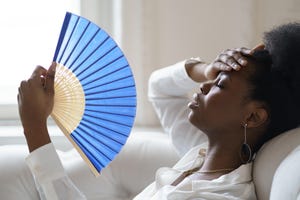Last year’s high temperatures set records, prompting the US Department of Labor to remind employers to protect workers exposed to extreme heat. Among certain populations — like older adults, young children, people who are less mobile and those with certain health conditions — people whose jobs keep them outside or in extreme heat are more susceptible to heat illness. That includes heatstroke, which can be fatal and is the most serious form of heat-related illness. Summer 2024 is predicted to be a scorcher, according to a forecast by The Weather Channel. Here’s how to prepare for it.
Heatstroke can happen because of overexertion or strenuous activity, but “classic” heatstrokes occur when someone is exposed to a hot environment and their body temperature rises to dangerous levels. Most fatal heat illnesses happen in workers during the first few days of working in warm or hot weather, according to the Labor Department, because the body’s had no time to acclimate to the increased temperature.
We see heatstroke “particularly among the elderly, in very young children, like babies, and when we see these heat waves that go on for several days,” said Dr. Korin Hudson, an emergency room physician with MedStar Health.
Here’s what to know if you or someone near you starts experiencing symptoms of heatstroke.
Read more: Is It Heatstroke or Heat Exhaustion?
Heatstroke symptoms
Sometimes, heatstroke can start with symptoms of heat exhaustion, which isn’t quite as serious as heatstroke, but still requires someone to cool down as quickly as possible. Symptoms of heat exhaustion include nausea, headache, cold skin, a fast or weak pulse and other signs. If left untreated, heat exhaustion can progress to heatstroke, which is a medical emergency. If your symptoms worsen, last more than one hour or you start vomiting, call 911.
Symptoms of heatstroke, according to the Mayo Clinic and the US Centers for Disease Control and Prevention, include:
Altered mental state, including confusion, agitation and slurred speechHot, flushed, usually dry skin (however, if your heatstroke was brought on by exercise, it may be slightly moist, the Mayo Clinic says)HeadacheSeizuresVery high body temperature (104 degrees Fahrenheit or higher)Rapid breathingRacing heart beat
Keeping hydrated by drinking enough water, both before you head outdoors and while you’re out in the heat, is an important step to warding off heat illness.
Peter Cade/Getty Images
1. Call 911
Having heatstroke is a medical emergency that requires professional care.
If there’s more than one person around to aid the person suffering heatstroke, Hudson advises that one person call 911 while the other helps the victim through the steps below.
2. Get to a cooler area immediately
If you’re around someone who has heatstroke, move them to a cooler area, such as a nearby air-conditioned room or into the shade.
Both are good options, but “try to move them out of the heat as quickly as possible,” Hudson says. The goal is to cool down the body’s core temperature.
3. Take off excess clothing
Removing long-sleeve shirts, pants or other clothing will help a person cool down faster. Hudson says the goal is to reach “evaporative cooling,” and clothing can prevent evaporation. You can also consider cooling clothes that work with your body to keep you cooler and more comfortable.
(For people who choose to run in layers in order to “sweat off weight,” says Hudson, you probably shouldn’t. It’s dangerous and can lead to heatstroke.)
4. Hold ice, cold towels or cool water to the skin
If you have something like a cold towel or water bottle, put it on your or the other person’s neck, armpits or groin. While you wait for help to arrive, you can even spray them with cold water or put them in a cold shower — anything to cool them off. In fact, cold water immersion or an ice bath is one treatment for heatstroke that doctors may use at the hospital.
But don’t give a drink to someone experiencing heatstroke, the CDC says. This is different advice than for someone who’s experiencing heat exhaustion, which typically comes before heatstroke. While someone with heat exhaustion may be given sips of water or sports drink, a person experiencing heatstroke may be confused, lose consciousness or have an altered state of consciousness.
“Because they have a depressed or altered level of consciousness, it may affect their ability to swallow safely, so it’s probably better not to give them anything to eat or drink,” she says.
Check on your neighbors
Some people are more susceptible to heat illness and heatstroke, such as older adults, younger children, people with mobility issues, certain health conditions and those taking certain medications, including common drugs like blood pressure or antidepressant medications.
In case of a heat wave, be especially mindful to check in with your elderly neighbor down the hall, or a friend who has trouble getting around, according to Hudson.
“This is the time that we really suggest people check on their neighbors,” she said. “Especially in places where people don’t have access to air conditioning or don’t have a way to get someplace cool.”
“They may be feeling poorly but can’t do anything about it,” Hudson added.
>>> Read full article>>>
Copyright for syndicated content belongs to the linked Source : CNET – https://www.cnet.com/health/medical/heatstroke-awareness-how-to-spot-prevent-and-respond-to-emergencies/#ftag=CAD590a51e































